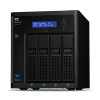Western Digital My Cloud EX4100 User Manual - Page 98
System Diagnostics, Diagnostic Tests, Viewing System Logs, Extended Logging
 |
View all Western Digital My Cloud EX4100 manuals
Add to My Manuals
Save this manual to your list of manuals |
Page 98 highlights
System Diagnostics Run system diagnostic tests if you are having problems with your device. You can also view your system logs, and enable extended logging for your diagnostics. Diagnostic Tests There are three types of diagnostic tests: Quick Test: The quick test checks the hard drives for major performance problems. The result of a quick test is a pass or fail evaluation of the hard drive's condition. The quick test can take several minutes to complete. Full Test: The full test is a more comprehensive drive diagnostic. It methodically tests each and every sector of the hard drives. You will be informed of the condition of the hard drive once the test is performed. The full test may take hours to complete, depending on the size and data configuration of the hard drives. System Test: The system test reviews the health of your device hardware (hard drives, fan, system clock, and device temperature). Running a Diagnostic Test: 1. On the Utilities page, click Quick Test, Full Test, or System Test. A progress bar appears, indicating test progress and whether the device passed or failed the test. 2. Review the test results and click Close. If the device fails the test, click Help icon at the top of the page, then click Support to get assistance. Viewing System Logs System logs provide a list of the events occurring on your device. Use the following steps to view your system logs. 1. In the Diagnostics area, click View Logs. 2. On the View Logs dialog, review the device log entries. To customize the log: Select the Log Level from the pull-down menu. Select Filter By option from the pull-down menu. To clear the log, click Clear. 3. Once you've reviewed the log, click Close. Extended Logging To capture extended logs in your diagnostics. Ensure that there are no backups, file activity, or file transfers being performed prior to extending your logging capability. Click the toggle button to turn on extended logging, then click OK. WD MY CLOUD USER MANUAL 92















